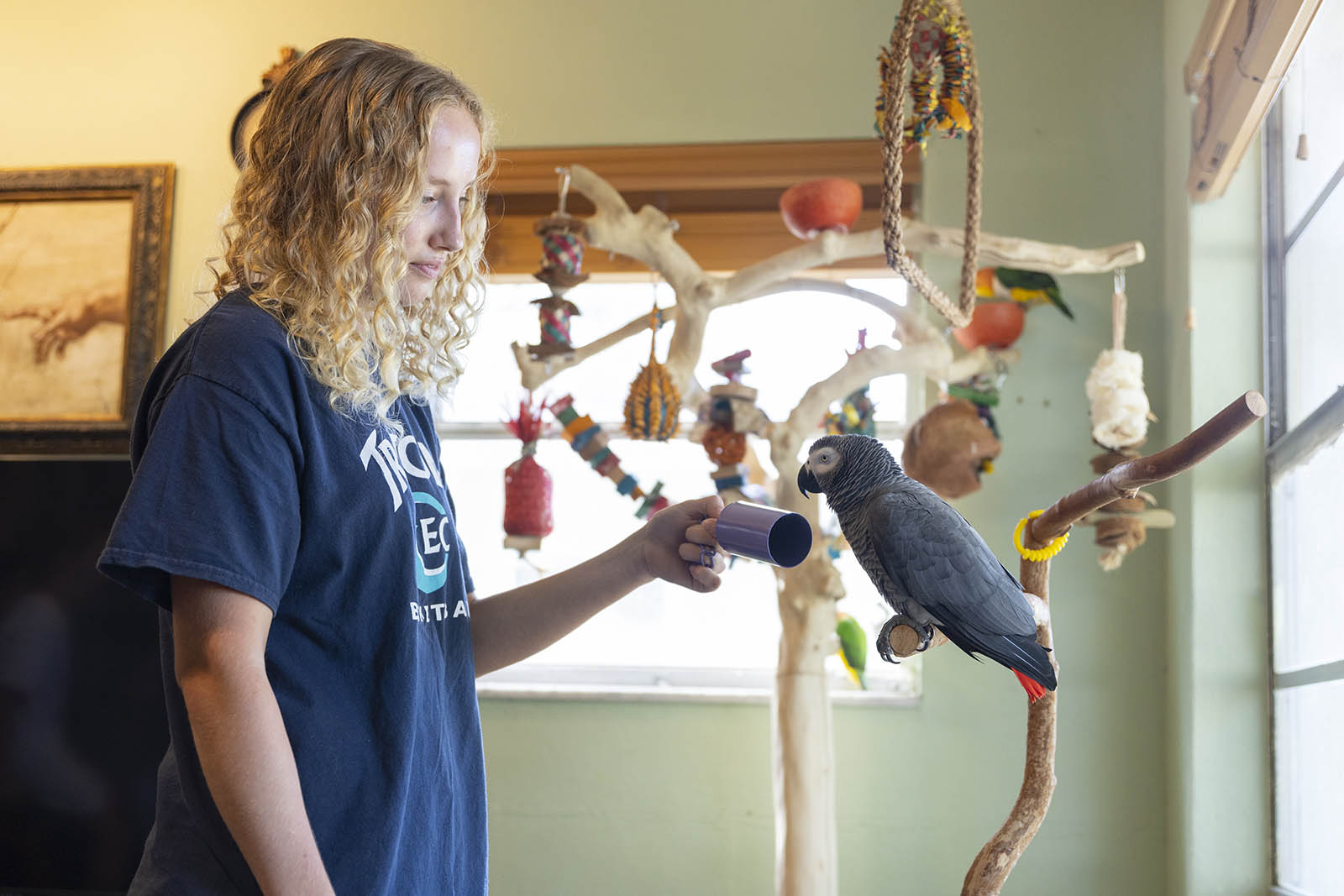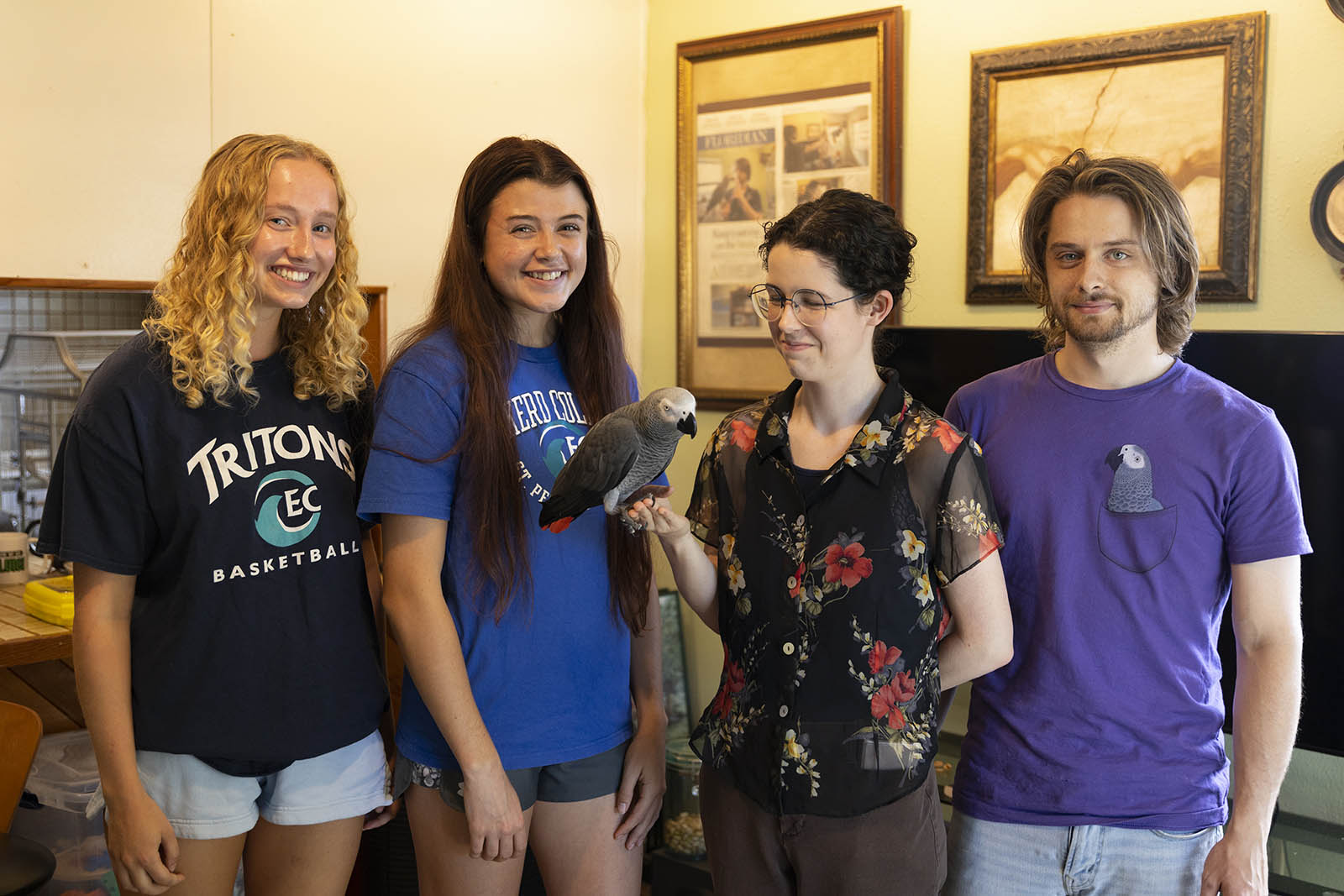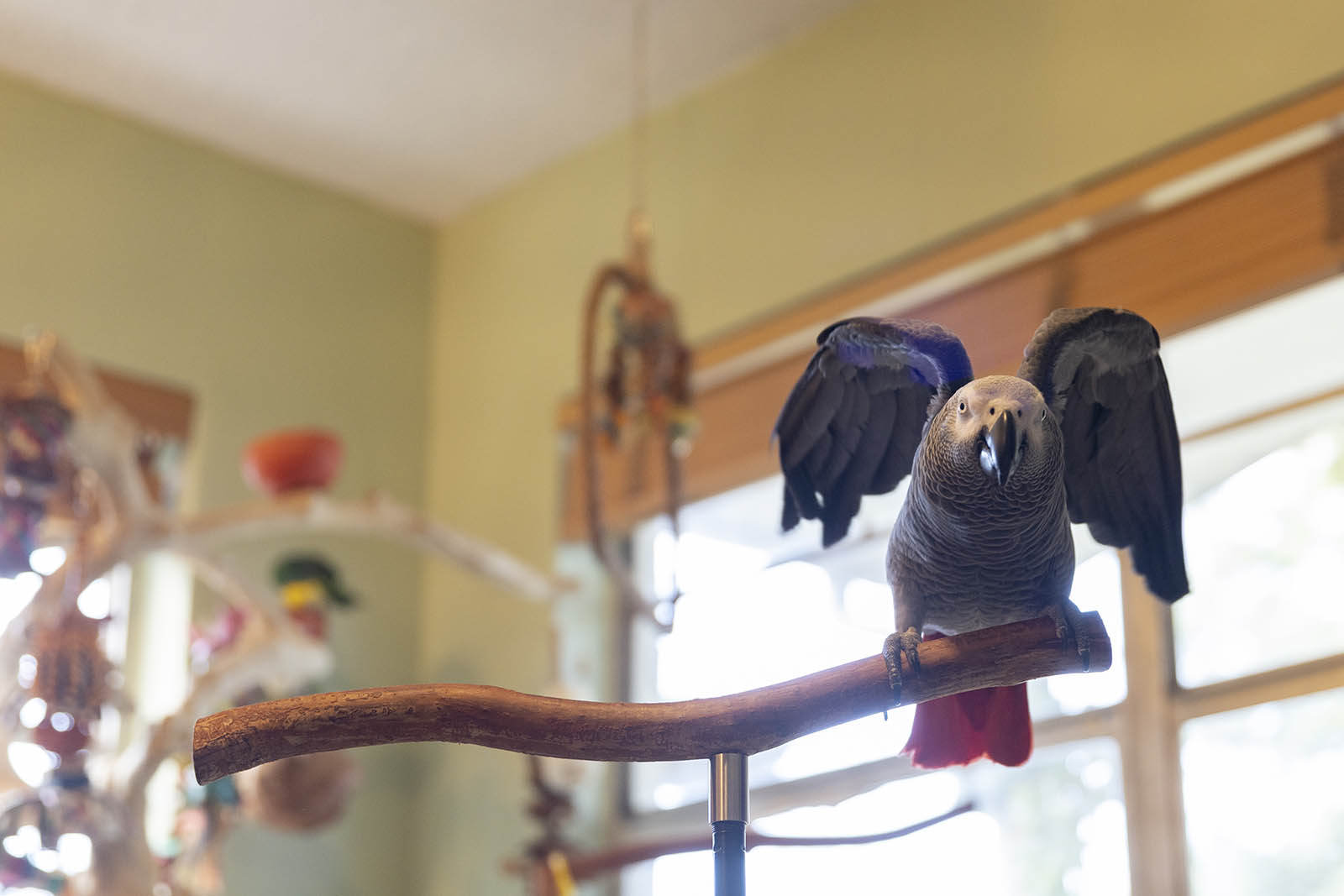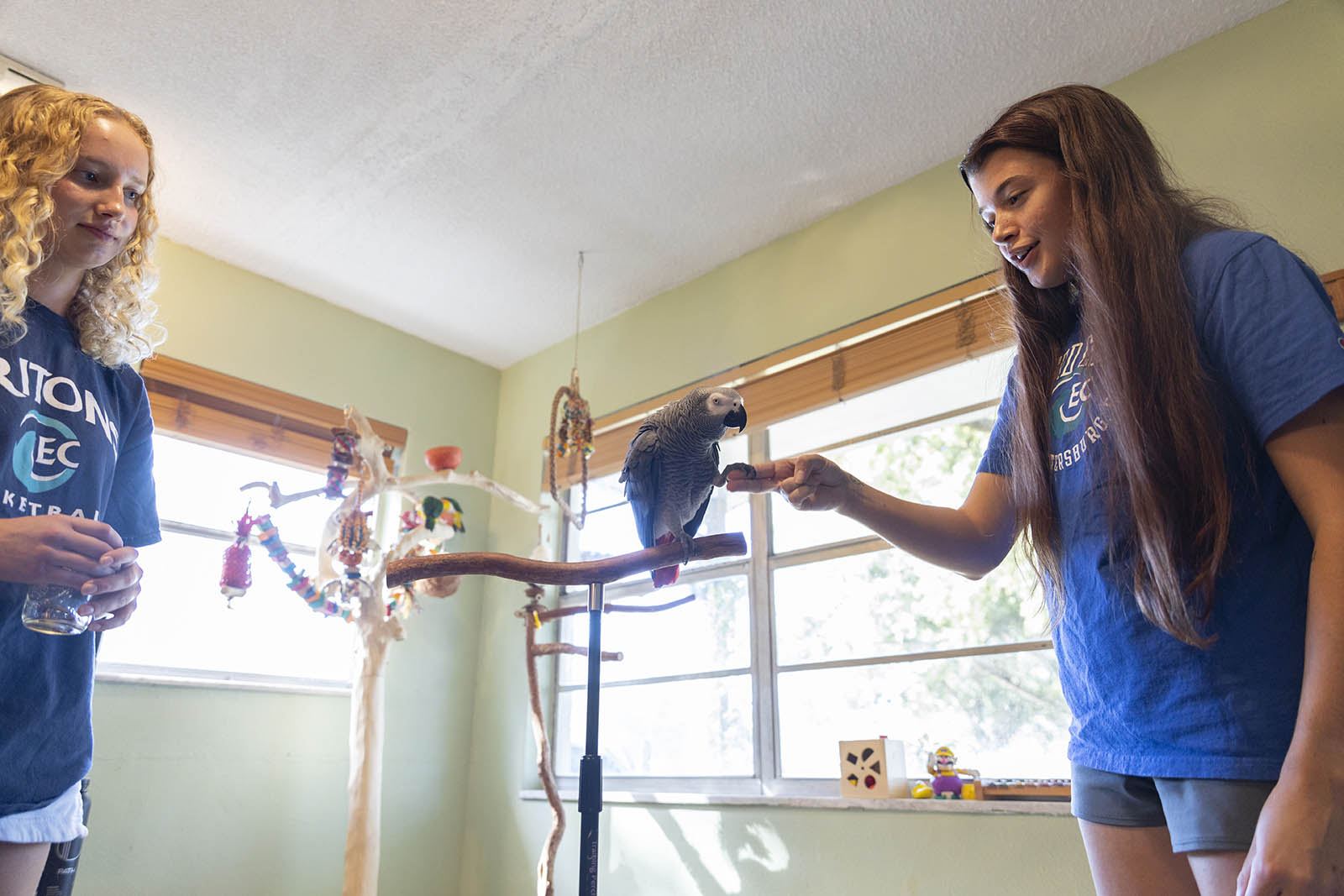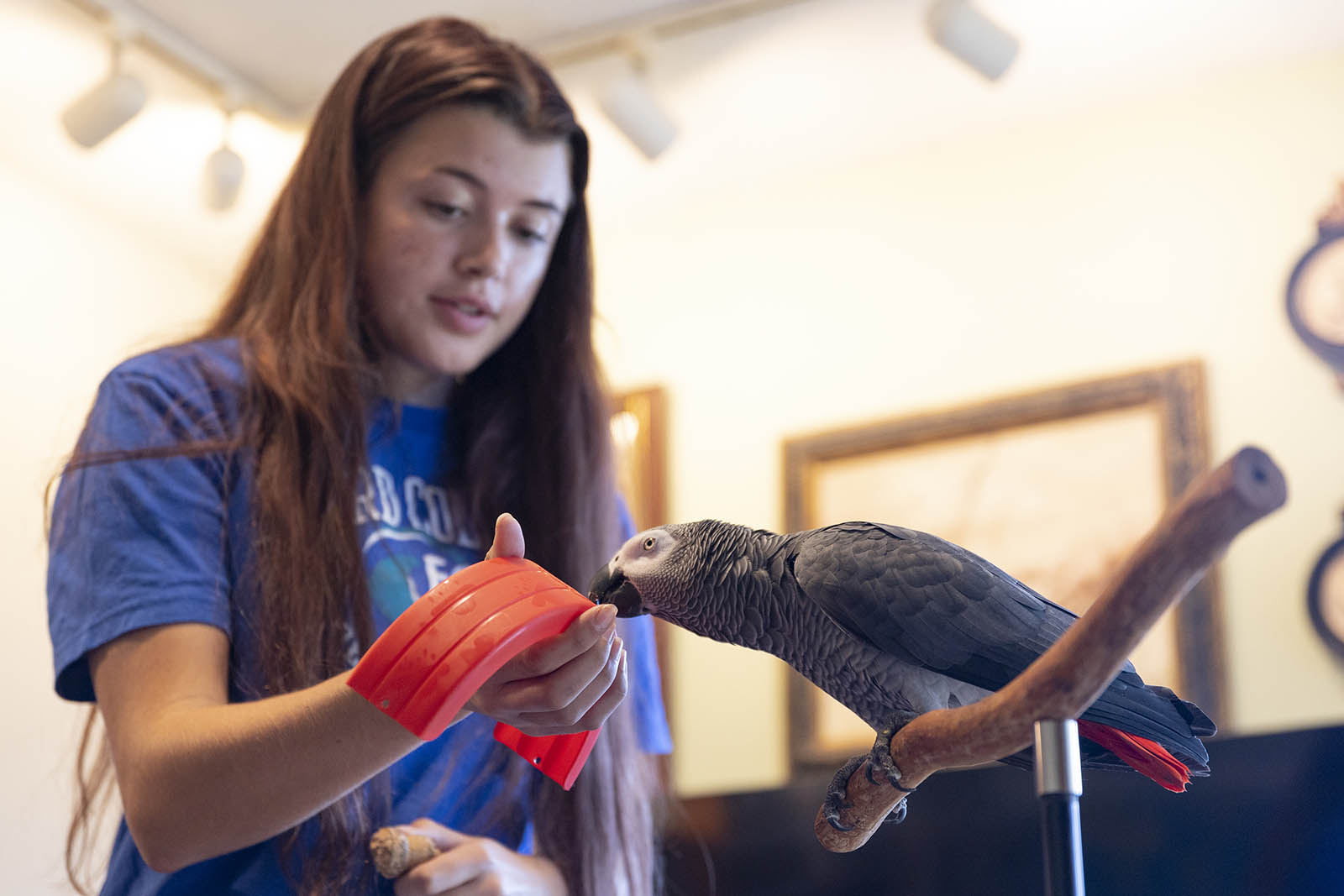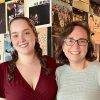When the door to the green stucco house opens, Apollo—an African grey parrot—squawks “Hello!” in his raspy voice. He’s famous on TikTok for having the vocal capacity of a human toddler and has gained 850,000 followers since September 2021.
Eckerd College Professor of Psychology and Animal Studies Lauren Highfill, Ph.D., read a Tampa Bay Times article about Apollo in June. She was impressed by the linked video and owners Dalton Mason and Tori Lacey’s use of scientific training techniques. Highfill wanted to learn more. This kind of research would be a fantastic opportunity for student researchers, especially since Apollo lives so close to the College, in St. Petersburg, Florida.
“I slid into Apollo’s DMs,” Highfill says about the beginning of her relationship with Mason and Lacey. “They were very open and receptive to the prospect of expanding his training.”
Six Eckerd students are now on the project. They visit Apollo’s house in pairs for about two hours three days a week. The research team includes: Gracie Barrentine, a sophomore animal studies and psychology student from Nashville, Tennessee; Ansley Bossart, a sophomore animal studies student from Milton, Georgia; Ashley Morack, a junior marine science and animal studies student from Appleton, Wisconsin; Mackenzie Smith, a junior marine science and animal studies student from Millis, Massachusetts; Kelly Kress, a junior marine science and animal studies student from Freehold, New Jersey; and Char McIntosh-DeCiancio, a senior biology and animal studies student from Mesa, Arizona.
A seat on the fluffy brown couch at Mason and Lacey’s house is an invitation for Apollo to get to know you. He may pick at your bracelets, especially if they’re shiny, or bite at your shoelaces. If you’re lucky, he may even shake your hand with his foot. Apollo’s fame and skill have allowed his owners to monetize their online content, which has given Lacey the freedom to quit her part-time retail job. Various media outlets have conducted interviews and written stories about Apollo’s intelligence.
@apolloandfrens Apollo having some fun in the Comparative Psychology Lab @Eckerd College 🎓 #talkingparrot #africangrey #amazinganimals #smartbird ♬ original sound - ApolloandFrens
During a training session, student-researcher Ashley Morack holds up a red bell for Apollo to see.
“Apollo, for a pistachio, what’s this made of?” she asks.
Apollo hits the bell with his beak, making it clang. “Metal,” the bird says in his creaky voice.
“Good bird!” Ashley says, reinforcing the right answer with praise. “What color is it?”
“White,” Apollo responds.
“No. What color is this?”
He tries again, this time producing the correct answer: “Red.”
“Okay, earn a pistache. What’s this called?” Ashley urges.
“It’s a bell.”
“Good bird!” She throws the pistachio in front of him on the floor, and he cracks it open with his beak, scattering shell bits everywhere.
Mason and Lacey’s home has become a sort of bird sanctuary for Apollo and his sisters, a pair of caique parrots named Soleil and Ophelia. Wire cages stand tall behind the couch, and a spare bedroom is strung with various toys, perches and climbing nets. The couple have been together for over five years and have raised Apollo since he was 8 months old.
“Dalton wanted a parrot,” Lacey recalls about their decision to adopt. “And he knew he wanted to make it smart.”
Parrot researcher Irene Pepperberg, Ph.D., used the model/rival technique to train her birds. When using this method, a human demonstrates the model response by doing what the researcher tells them to do, and they are rewarded with nuts the way a parrot would be. When the parrot sees the person being rewarded, the bird is motivated to perform the same behavior to get the reward. The person’s success makes the parrot want to one-up them, and a rivalry is formed. When Mason and Lacey learned about this technique, they decided to integrate it into Apollo’s training.
African greys can mimic sounds using special muscles in their necks, which allows them to communicate in the human language. Under his owners’ care, Apollo has learned to use his voice to answer questions and convey his needs and desires. “Want fresh water” and “earn a snack” are some of his go-to phrases. He can identify most colors and even some materials and objects. He also performs physical tricks like “flap,” “shake” and “step up.” Right now, they are trying to get him comfortable with a harness, so he can go outside for fresh air.
Apollo’s days are very structured. He’s generally more eager to train in the morning, around 9 a.m. Most of his tricks are food-motivated. Pistachios are his favorite snack, so they have the highest value; he has to do more tricks to “earn a pistache.”
Training sessions depend on his mood that day. If he wants to focus on certain words, that’s what they do. If he’d rather play and explore, they allow him that freedom. He’s much more likely to learn if he’s interested in something.
“I love this because it is Apollo’s choice,” says Ashley. “He is allowed to be a bird.”
He also has a designated “learning hour” each day. After his lunch of poultry eggs, organic seasonal vegetables, and bee pollen, Apollo often can be found in his birdcage, reciting words to himself. He is reviewing all the things he learned, and strengthening all the connections he made that day. During this time, it’s very important that there is no negative reinforcement from the owners, and no rewards are given. They do repeat some of the words he says, and they give verbal affirmation when he is correct.
Apollo is naturally sociable, so he’s not motivated only by food. When someone new is around, he works hard to impress them. He craves social validation and is therefore less interested in snacks when company is over. He loves attention, which is why the model/rival technique works.
Because of his inquisitive personality, he’s very interested in the things Mason and Lacey use in their daily lives. When Mason was doing some electrical work in the house, Apollo was curious about the tools he was using, so Lacey found him a play toolset. He was particularly interested in the orange hammer, tossing it around and saying “plastic.”
This is an important research study because the parrot’s linguistic ability opens a gateway of understanding between two species, according to Professor Highfill. Birds’ brains are small, she says, so they haven’t been given as much attention from the scientific community as primates and marine mammals have. But parrots have the ability to communicate with us as well as with other parrot species, which could be huge in the world of animal cognition. They can ask humans questions to accelerate their own learning.
Additionally, Mason and Lacey are interested in how a loving home will impact his learning. All of Dr. Pepperberg’s parrots were kept in a university lab. At home, Apollo’s owners get to raise him as if he is a child.
“I believe in parrot rights,” says Lacey when asked about their long-term goals for Apollo. They just want him to be happy and healthy. As far as the research, they will keep teaching him new things until he no longer wants to learn.





